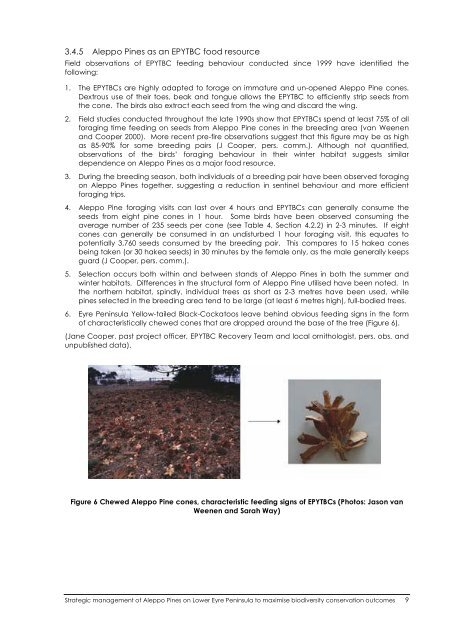Strategic management of Aleppo Pines on Lower Eyre
Strategic management of Aleppo Pines on Lower Eyre
Strategic management of Aleppo Pines on Lower Eyre
Create successful ePaper yourself
Turn your PDF publications into a flip-book with our unique Google optimized e-Paper software.
3.4.5 <str<strong>on</strong>g>Aleppo</str<strong>on</strong>g> <str<strong>on</strong>g>Pines</str<strong>on</strong>g> as an EPYTBC food resource<br />
Field observati<strong>on</strong>s <str<strong>on</strong>g>of</str<strong>on</strong>g> EPYTBC feeding behaviour c<strong>on</strong>ducted since 1999 have identified the<br />
following:<br />
1. The EPYTBCs are highly adapted to forage <strong>on</strong> immature and un-opened <str<strong>on</strong>g>Aleppo</str<strong>on</strong>g> Pine c<strong>on</strong>es.<br />
Dextrous use <str<strong>on</strong>g>of</str<strong>on</strong>g> their toes, beak and t<strong>on</strong>gue allows the EPYTBC to efficiently strip seeds from<br />
the c<strong>on</strong>e. The birds also extract each seed from the wing and discard the wing.<br />
2. Field studies c<strong>on</strong>ducted throughout the late 1990s show that EPYTBCs spend at least 75% <str<strong>on</strong>g>of</str<strong>on</strong>g> all<br />
foraging time feeding <strong>on</strong> seeds from <str<strong>on</strong>g>Aleppo</str<strong>on</strong>g> Pine c<strong>on</strong>es in the breeding area (van Weenen<br />
and Cooper 2000). More recent pre-fire observati<strong>on</strong>s suggest that this figure may be as high<br />
as 85-90% for some breeding pairs (J Cooper, pers. comm.). Although not quantified,<br />
observati<strong>on</strong>s <str<strong>on</strong>g>of</str<strong>on</strong>g> the birds’ foraging behaviour in their winter habitat suggests similar<br />
dependence <strong>on</strong> <str<strong>on</strong>g>Aleppo</str<strong>on</strong>g> <str<strong>on</strong>g>Pines</str<strong>on</strong>g> as a major food resource.<br />
3. During the breeding seas<strong>on</strong>, both individuals <str<strong>on</strong>g>of</str<strong>on</strong>g> a breeding pair have been observed foraging<br />
<strong>on</strong> <str<strong>on</strong>g>Aleppo</str<strong>on</strong>g> <str<strong>on</strong>g>Pines</str<strong>on</strong>g> together, suggesting a reducti<strong>on</strong> in sentinel behaviour and more efficient<br />
foraging trips.<br />
4. <str<strong>on</strong>g>Aleppo</str<strong>on</strong>g> Pine foraging visits can last over 4 hours and EPYTBCs can generally c<strong>on</strong>sume the<br />
seeds from eight pine c<strong>on</strong>es in 1 hour. Some birds have been observed c<strong>on</strong>suming the<br />
average number <str<strong>on</strong>g>of</str<strong>on</strong>g> 235 seeds per c<strong>on</strong>e (see Table 4, Secti<strong>on</strong> 4.2.2) in 2-3 minutes. If eight<br />
c<strong>on</strong>es can generally be c<strong>on</strong>sumed in an undisturbed 1 hour foraging visit, this equates to<br />
potentially 3,760 seeds c<strong>on</strong>sumed by the breeding pair. This compares to 15 hakea c<strong>on</strong>es<br />
being taken (or 30 hakea seeds) in 30 minutes by the female <strong>on</strong>ly, as the male generally keeps<br />
guard (J Cooper, pers. comm.).<br />
5. Selecti<strong>on</strong> occurs both within and between stands <str<strong>on</strong>g>of</str<strong>on</strong>g> <str<strong>on</strong>g>Aleppo</str<strong>on</strong>g> <str<strong>on</strong>g>Pines</str<strong>on</strong>g> in both the summer and<br />
winter habitats. Differences in the structural form <str<strong>on</strong>g>of</str<strong>on</strong>g> <str<strong>on</strong>g>Aleppo</str<strong>on</strong>g> Pine utilised have been noted. In<br />
the northern habitat, spindly, individual trees as short as 2-3 metres have been used, while<br />
pines selected in the breeding area tend to be large (at least 6 metres high), full-bodied trees.<br />
6. <strong>Eyre</strong> Peninsula Yellow-tailed Black-Cockatoos leave behind obvious feeding signs in the form<br />
<str<strong>on</strong>g>of</str<strong>on</strong>g> characteristically chewed c<strong>on</strong>es that are dropped around the base <str<strong>on</strong>g>of</str<strong>on</strong>g> the tree (Figure 6).<br />
(Jane Cooper, past project <str<strong>on</strong>g>of</str<strong>on</strong>g>ficer, EPYTBC Recovery Team and local ornithologist, pers. obs. and<br />
unpublished data).<br />
Figure 6 Chewed <str<strong>on</strong>g>Aleppo</str<strong>on</strong>g> Pine c<strong>on</strong>es, characteristic feeding signs <str<strong>on</strong>g>of</str<strong>on</strong>g> EPYTBCs (Photos: Jas<strong>on</strong> van<br />
Weenen and Sarah Way)<br />
<str<strong>on</strong>g>Strategic</str<strong>on</strong>g> <str<strong>on</strong>g>management</str<strong>on</strong>g> <str<strong>on</strong>g>of</str<strong>on</strong>g> <str<strong>on</strong>g>Aleppo</str<strong>on</strong>g> <str<strong>on</strong>g>Pines</str<strong>on</strong>g> <strong>on</strong> <strong>Lower</strong> <strong>Eyre</strong> Peninsula to maximise biodiversity c<strong>on</strong>servati<strong>on</strong> outcomes 9

















